Understanding Different Types of Shade: Full, Partial, and Dappled
Understanding different types of shade – full, partial, and dappled – is key for garden success. Full shade gets less than 3 hours of direct sunlight, partial shade 4-6 hours, and dappled shade has filtered light patterns. Full shade suits low-light plants, while partial shade allows for more variety. Full shade is low light with dense cover, partial is ideal for morning sun, and dappled offers balanced light. Choose Lily of the Valley for full shade, daylilies for partial, and Foam Flower for dappled. Knowing these shades helps plant growth thrive.
Importance of Different Shade Types
In understanding the significance of various shade types, we investigate the subtle characteristics that directly impact plant growth and health. Shade plays a vital role in determining the well-being of plants, as it influences the amount of light reaching them. There are three main types of shade: full shade, partial shade, and dappled shade, each with distinct qualities that affect plant development differently.
Full shade, receiving less than 3 hours of direct sunlight daily, is suitable for plants adapted to low light conditions. These plants have evolved mechanisms to thrive with minimal sunlight, making them ideal choices for areas with constant shade. However, it is crucial to select shade-loving species that can flourish under these conditions to promote their health and growth.
Partial shade, also known as part shade, provides 4-6 hours of sunlight daily, offering a balanced environment for plants that can tolerate varying light levels. This type of shade allows for more flexibility in plant selection, as it accommodates species that can adapt to different lighting conditions. Choosing the right plants for partial shade areas is vital to promote their overall health and vitality.
Dappled shade creates a unique environment with filtered light patterns, ideal for certain flowering plants and shrubs. The shifting sunlight through trees creates a gentle ambiance that benefits specific plant species. Understanding the characteristics of dappled shade is vital for selecting plants that can thrive in this intricate lighting condition, ensuring their best growth and well-being.
Characteristics of Full Shade
Full shade areas are characterized by low light conditions, which means they receive less than 3 hours of direct sunlight per day. The dense vegetation cover in full shade locations can limit the amount of sunlight reaching plants, impacting their growth. With limited direct sunlight available, plants in full shade may struggle to thrive and require species that are specifically adapted to low light environments.
Low Light Conditions
Exploring the intricacies of low light conditions reveals the challenges faced by plants in full shade environments. In full shade, where plants receive less than 3 hours of direct sunlight daily, the limited light and water availability can cause struggles for plant growth. To mitigate these challenges, it is essential to open up the canopy slightly to increase light levels in full shade areas. Additionally, creating mulched or graveled spaces can aid plants in coping with dry shade conditions often found in full shade environments. When gardening in low light environments, it is vital to choose suitable plants that are well-adapted to thrive in low light and dry shade conditions for successful growth in full shade areas.
Dense Vegetation Cover
Amidst dense vegetation cover in full shade environments, the challenge lies in the limited sunlight availability and competition for resources among plants. In dense shade areas, characterized by a lack of direct sunlight and limited indirect light, plant selection becomes important. The restricted plant selection is primarily due to the lack of sunlight, leading to issues like root competition and dry soil conditions. Plants in dense shade struggle with growth and flowering due to inadequate light availability, impacting their overall health. Understanding the challenges of dense shade areas is essential for choosing suitable plant species that can thrive in low light conditions. Proper consideration of these factors is necessary to create a thriving garden or landscape in full shade settings.
Limited Direct Sunlight
Limited direct sunlight poses significant challenges for plants in full shade environments, impacting their growth and overall health due to the minimal light exposure. In full shade, where light levels are low, plants often struggle to photosynthesize efficiently, leading to stunted growth and reduced vitality. To combat this issue, consider creating small openings in the canopy to allow increased light penetration. Additionally, utilizing mulched or graveled spaces can help reflect light onto plants, aiding in their survival. Container gardening is a practical solution for areas with limited sunlight, as it allows for better light management and mobility to find the best light conditions. By understanding and addressing the effects of limited direct sunlight in full shade environments, plants can thrive despite challenging light conditions.
Characteristics of Partial Shade
Partial shade offers 4-6 hours of sunlight daily, essential for plants adapting to varying light levels. Morning sun exposure is ideal, providing gentle rays that aid in sugar production for plant growth. It’s a versatile condition, allowing experimentation to determine which plants flourish best in this setting.
Light Levels in Partial Shade
Receiving 3-6 hours of sun/shade daily, plants in partial shade benefit greatly from the morning sunlight for best growth and sugar production. The light levels in partial shade play an essential role in plant development. With 3-4 hours of morning sun exposure, landscape plants flourish in partial shade conditions. Morning sun is important for sugar production in plants, making it a critical component of their growth cycle. Plants in partial shade can tolerate up to 4-5 hours of sun, with the morning sunlight being most beneficial for their overall health. Understanding the shade patterns and light requirements of plants in partial shade is key to ensuring their best growth and development.
Plant Adaptation Strategies
In the context of plant adaptation strategies within partial shade environments, the characteristics of sunlight exposure play a crucial role in determining the success of various plant species.
- Sunlight Exposure: Plants in partial shade receive 3-6 hours of sun daily, with morning sun and some afternoon protection being ideal.
- Adaptation of Sun-Loving Plants: Some sun-loving plants can adjust to partial shade conditions, thriving with gentler morning sunlight.
- Suitable Plant Choices: Common choices for partial shade include day lilies and garden phlox, which can withstand 4-6 hours of sunlight.
- Experimentation for Optimal Growth: Trying different plant species in partial shade can help identify which plants thrive best in these conditions.
These strategies highlight the importance of understanding light exposure for successful plant growth in partial shade.
Characteristics of Dappled Shade
Dappled shade, characterized by filtered light patterns created by the interplay of foliage, is essential for nurturing specific plants requiring a balanced light exposure. This type of shade provides 2-4 hours of dappled sunlight, making it ideal for shrubs like rhododendron, which thrive in such conditions. The balanced light exposure in dappled shade is particularly beneficial for flowering plants that prefer some sunlight but need protection from intense rays.
Strategically planted trees can be used to create dappled shade in a gardening environment. By trimming tree branches, gardeners can manipulate the light filtering through, offering the perfect conditions for plants that thrive in this type of shade. Dappled shade not only protects plants from harsh sunlight but also creates a visually appealing pattern on the ground, adding to the aesthetics of the garden.
In a garden setting, dappled shade can be naturally occurring, such as when neighboring houses or strategically planted trees cast patterns of light and shadow. Understanding how to utilize dappled shade effectively can improve the growth and health of plants that require this specific light environment.
Plants Suitable for Full Shade
Plants suitable for full shade are specifically adapted to low light and water conditions, thriving in areas that receive less than 3 hours of direct sunlight daily. Here are some key points to keep in mind when selecting and maintaining plants for full shade:
- Adaptation to Low Light and Water Conditions: Plants suitable for full shade, such as Lily of the Valley and Creeping Mint, have evolved to thrive in environments with limited direct sunlight and lower moisture levels. They have mechanisms to efficiently utilize available light and water.
- Proper Plant Selection: When choosing plants for full shade, it is crucial to pick species that are known to perform well in low-light conditions. These plants are more likely to flourish and remain healthy in areas with minimal direct sunlight.
- Increasing Light Exposure: To help plants in full shade thrive, contemplate methods to enhance light exposure. This can be achieved by selectively thinning out overhead canopy cover or strategically placing reflective surfaces to redirect sunlight towards the shaded area.
- Optimal Growing Conditions: Creating mulched or graveled spaces around plants can assist in maintaining ideal growing conditions in full shade areas. These materials can help retain moisture, regulate soil temperature, and reduce competition from other vegetation.
Plants Suitable for Partial Shade
Adapting to environments with varying light exposure, certain plant species excel in partial shade conditions, receiving 4-6 hours of sunlight daily. Plants suitable for partial shade fall under the categories of Part Sun and Part Shade, with different light requirements based on their characteristics. Some sun-loving plants can thrive in partial shade, benefiting from morning sun and protection from intense afternoon sunlight. Morning sun is gentler on plants in partial shade compared to harsh afternoon sun, promoting healthier growth.
When selecting plants for partial shade, it’s essential to contemplate the specific amount of light they need. Good plant choices for partial shade include daylilies and garden phlox, as they offer a mix of sun and shade tolerance, adapting well to the varying light conditions. These plants can utilize the 4-6 hours of sunlight efficiently, striking a balance between sun exposure and shade. Experimenting with different plants in partial shade can help gardeners find the perfect equilibrium for prime growth and beauty. By understanding the light requirements of each plant, gardeners can create a harmonious environment where sun-loving and shade-loving plants thrive together in partial shade conditions.
Plants Suitable for Dappled Shade
In shaded environments receiving 2-4 hours of light, specific plant species like rhododendrons thrive best due to their adaptation to dappled shade conditions. Plants that require dappled light benefit from the gentle filtering of sunlight that dappled shade provides. Here are some key points to keep in mind when selecting plants for dappled shade:
- Shade Means Protection: Dappled shade offers a balanced environment for plants, safeguarding them from harsh direct sunlight while still allowing for essential photosynthesis to take place.
- Healthy Plants: Plants suitable for dappled shade often display healthier growth patterns compared to those in full sun or deep shade, showcasing lush foliage and vibrant blooms.
- Suitable for Flowering Plants: Dappled shade is particularly ideal for flowering plants like Foam Flower and Woodland Phlox, as it allows them to bloom beautifully without the risk of being scorched by intense sunlight.
- Woodland Conditions: Creating dappled shade through tree trimming can replicate the natural conditions found in woodlands, providing an optimal setting for a diverse range of plant species to thrive.






